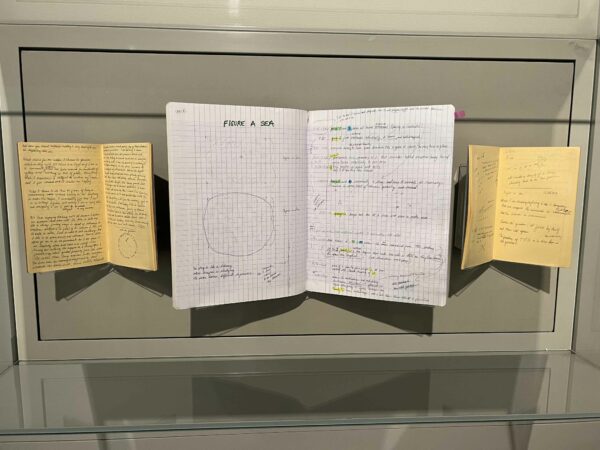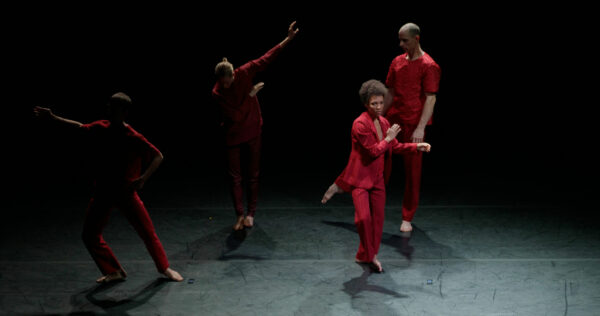Deborah Hay has a way with words. She is best known for her international career as a postmodern choreographer and dancer, which was celebrated joyfully with a full day of programming at Texas Performing Arts’ McCullough Theatre on January 28. The performance lineup included three live dance performances, three facilitated talkbacks, and a film screening. Each delighted in its own right, but it was during the talkback after the first performance, The Match, that she shared the framing question for dancers in her work: “What if every cell in my body has the opportunity to perceive here and now, the uniqueness and originality of time and space?”
It’s a question that could take a philosopher’s career to unpack, and yet under Hay’s direction, dancers embody it at the start of their first rehearsal. Perhaps dance has something to teach philosophy — that in fact some of life’s most profound questions are for the body and not the mind, and to answer them it will take a lifetime; it might not be the answer that we seek, but the process of seeking itself.
In action, the prompt is joyful, complex, and measured. The movements of the skilled bodies of six members of Swedish dance company Cullberg in The Match bring the aforementioned question to life with a complex, hour-long game. The question helps the audience make sense of the action on stage, even if they don’t know it while watching — many of us only learned the guiding question fifteen minutes after the performance ended. It was a delightful advance, a window into the process which creates performances that are rich, complex, and relatable. Hay explained that she asks dancers to do something which is impossible to achieve, for example to “jump without jumping.” The dancers must choose to continue to try, knowing that they will fail. The conundrum of the direction gives the dancers freedom once they give in to the inevitability of failure.
The Match is delightful, often funny, and carefully executed. It is easy to see that each dancer has indeed given in to the conundrum, and continues. They are all in on the game, together. Horse, the Solos uses the same choreographic framework, but with a vastly different outcome: the dancers are together, yet also isolated from one another, giving the piece a much more somber feel. The score composed and performed live by Graham Reynolds was dark, broody, and hard to locate. It was a cacophony of sounds and movements that didn’t work together, but were in the world together.
In a post-show discussion, Hay admitted it was the first time she’d seen the dance in full. Reynolds had not seen it either. It was a mixture of pandemic safety measures and Hay’s choreographic impossibilities. She worked with each dancer from Culburg virtually — sharing dance videos across Zoom, and relying on her longtime collaborator and rehearsal director Jeanine Durning to act as her proxy for rehearsals in Sweden. The premiere of the show was to an empty house in Sweden in the midst of the pandemic in 2021. Hay did not see it; in fact, no one did.
There is a sense of isolation in the piece that relates to the deeply lonely experience of quarantine, and to the beauty and pressure of dance soloists. It was a striking contrast to the rare dance solo that preceded it, my choreographed body… revisited. In it, Hay’s body moved carefully, curiously, and lit up with pleasure and vocalization at moments. The house lights and stage lights stayed up — it was a solo but we were also implicated in it and influencing it, it seemed. Hay describes her work as strictly non-improvisational, which might be surprising given the loose and conceptual frameworks she offers. Upon closer inspection it is clear that her works, and each dancer’s movements, are not improvisatory, but rather open to the experience of the exact moment they are in. How do they get to that place? What’s the process? Does it change them forever once they’ve begun to move within Hay’s framework?
I left the Day of Deborah Hay with many more questions, high on performance, and grateful that I could satisfy my thirst for more the following week at Keeping the Score: The Deborah Hay Papers, an exhibition of the artist’s recently acquired archive at the University of Texas’ Harry Ransom Center, on view until August 20. The Day of Deborah Hay at Texas Performing Arts was programmed in celebration of the acquisition, and if it was meant to pique audience interest in the archive, it worked (at least for this author.) I found myself in the back corner of the galleries at the Ransom Center slipping on headphones to watch a short video of Hay, squinting at reproductions of her score books, and wishing that I could flip the pages of those on display in glass vitrines.
The exhibition, curated by Dr. Eric Colleary, features highlights from the artist’s vast archive of audio visual documentation, score books, manuscripts, interviews, correspondences, and other performance ephemera. It features two full reproductions of the scores for Hay’s The Aviator (1989) and No Time to Fly (2010), showing the progression of her scoring techniques in the twenty one years between the two performances. Reading them evokes the desire to try out the movement whilst holding the book in hand. Surprisingly, there is not any documentation of performance in the exhibition; the only video included is an interview in which Hay discusses her practice. Visitors unfamiliar with the artist’s work might want to look up the artist on YouTube prior to visiting, or make an appointment to see the full archive. For those fascinated by artists’ attempts to document live performance, the exhibition is a must. Hay’s work is shown alongside Dawoud Bey’s photography and selections from Norman Mailer’s archive. Together the three are vastly different but equally beautiful attempts to represent ephemeral experiences through the lenses of movement, language, and vision.

Installation view of an object in “Keeping Score: The Deborah Hay Papers” at the Harry Ransom Center. Photo: Christine Gwillim
Keeping Score: The Deborah Hay Papers is part of the exhibition Stories to Tell: Selections from the Harry Ransom Center, on view through August 20, 2023. Admission to the Ransom Center is free.




